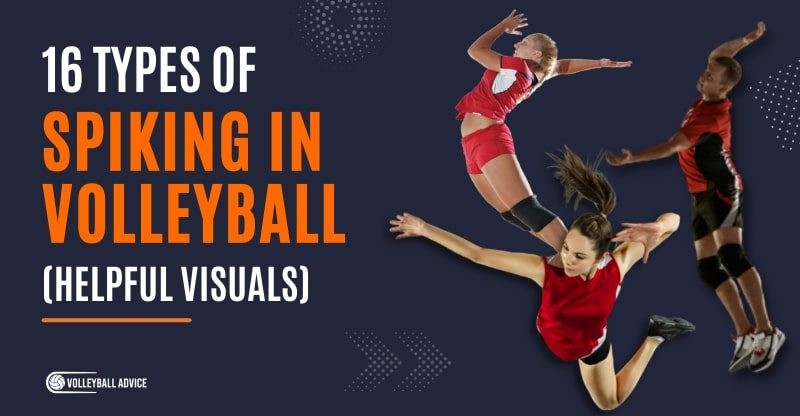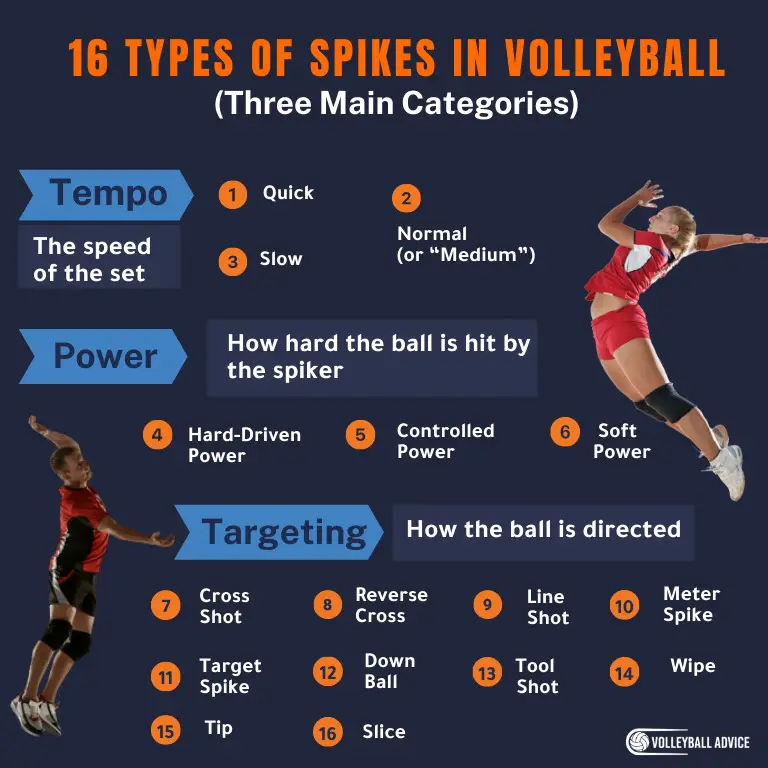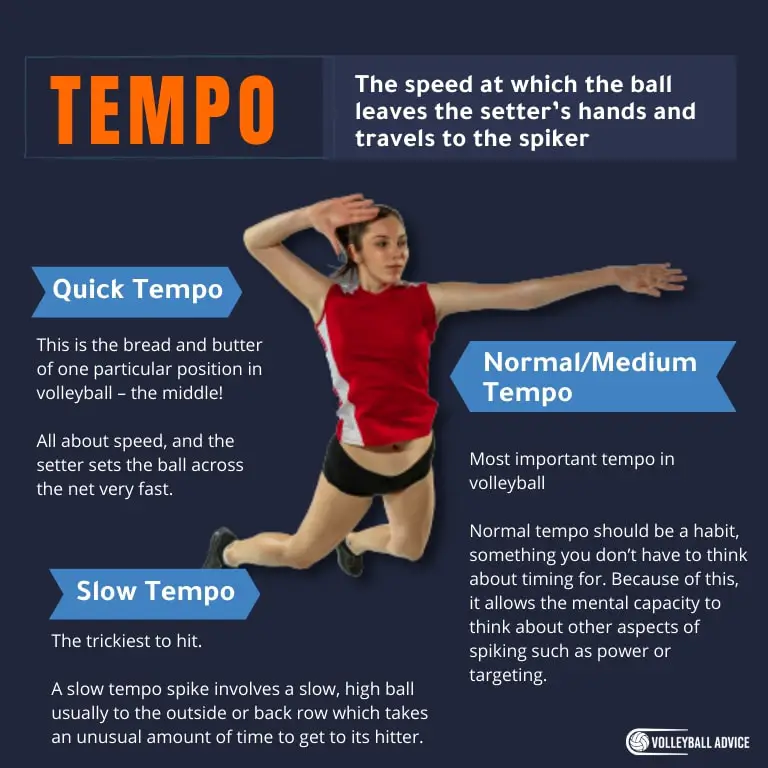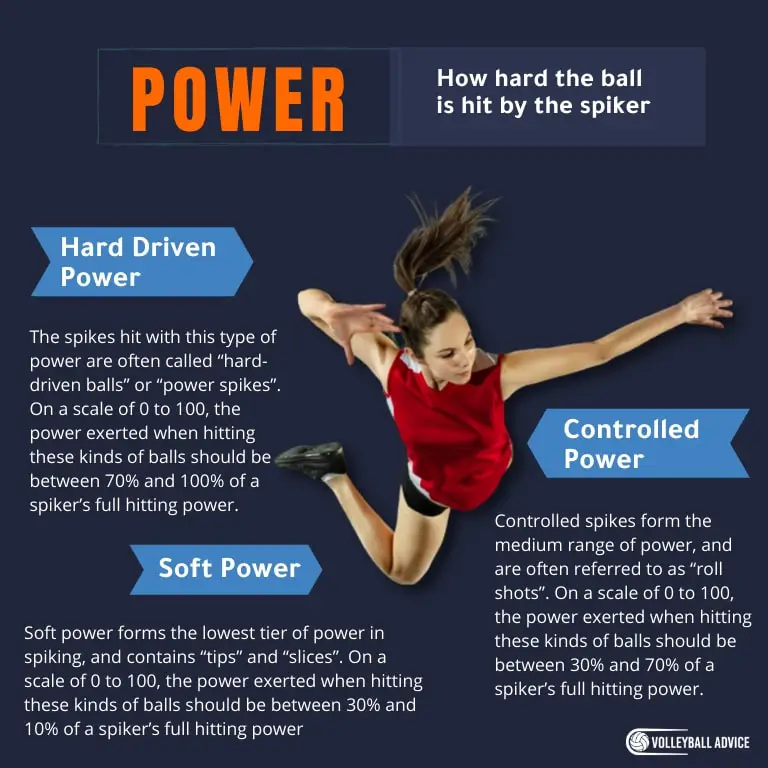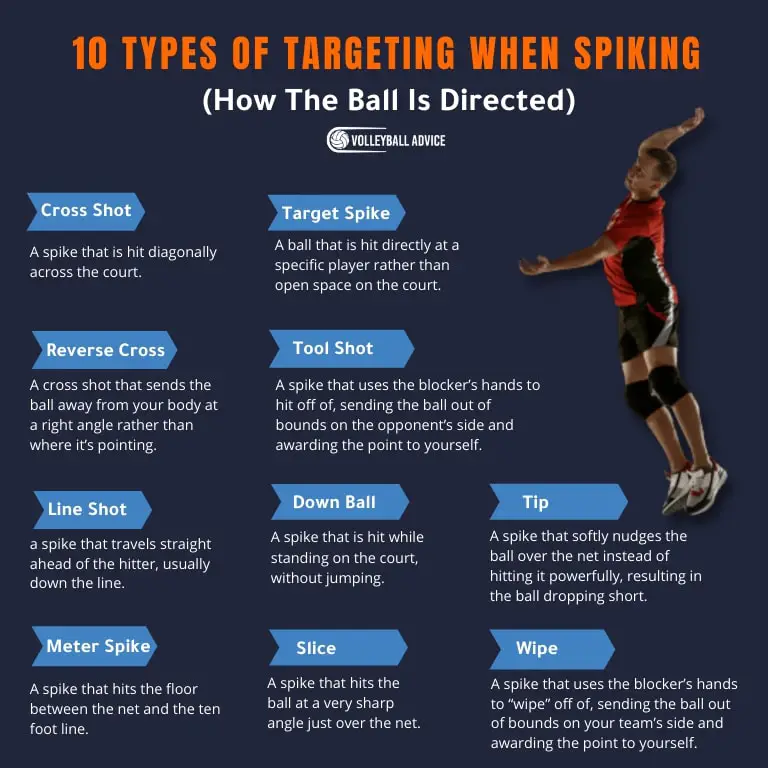16 Types of Spiking in Volleyball (Helpful Visuals)
Spiking is the most important offensive tool for a volleyball team and the primary method of scoring points.
While some may think of spiking as having a single shape or form, it is actually a multi-faceted weapon with many different paths to success.
The key is to know your options and choose the right one.
So, what are the types of spiking in volleyball? Spiking in volleyball is divided into three main categories: tempo (the speed of the set), power (how hard the ball is hit), and targeting (how the ball is directed). Different types of spikes are defined by these three categories and can be crafted from their individual pieces.
Most players, especially when they first begin playing volleyball, only use a single type of spike to score. While this may be fine for learning, it becomes predictable and easy to stop at high levels and can lead to intense frustration.
Worst of all, it can cost you a place on the court.
That’s why I’m going to break down the different types of spikes and how to execute them.
By the end of this article, you should be able to:
- Identify the different parts of a spike
- Know how to perform each individual element
- Understand in what situations they should be used
There are 16 types of spikes in volleyball within the categories of tempo, power, and targeting, so buckle in.
Spiking Type: Tempo
Tempo is the first aspect of spiking and denotes the speed at which the ball leaves the setter’s hands and travels to the spiker. In other words, it’s how fast the ball moves before it’s hit. This controls the timing of the hit, and how fast the point is played.
Tempo is important because if you hit at the same moment, at the same place, every single time, your spiking becomes predictable. And when your spiking is predictable, it’s easy to counter.
The three types of spiking tempos are:
- Quick
- Normal (or “Medium”)
- Slow
By changing the timing of the jump by increasing or decreasing the speed of the toss, you gain an advantage by surprising the opposition.
This can vary from a “shoot” (aka “quick” or “first” tempo), which travels across the net in under a second – low and fast to beat the block – to a “high ball” (aka “slow” or “third” tempo), which floats lazily to its destination over the course of a couple of seconds.
By giving the different spikers on their team different tempos to be ready for, thereby jumping at different times, the setter confuses the defense while you as a hitter have a higher chance of scoring.
Different clubs use different terms to discuss this, and while “first, second, and third” tempos are often used, I will be referring to them as “quick, normal, and slow” as these more easily convey the speed of the toss.
There is no technical difference between the terms, only preference, so feel free to use whichever works for you!
1. Quick Tempo
First up is the quick spiking tempo. This is the bread and butter of one particular position in volleyball – the middle!
If you’ve ever played middle blocker, you know better than most the power of a quick tempo spike. It’s fast, it’s deadly, and it’s extremely difficult to block, and by the time the other team has figured it out, it’s usually too late.
Quick spikes are all about speed, and the setter sets the ball across the net very fast.
For some positions – like the middle blocker – this is absolutely essential as a high ball in the middle will swiftly be ended by an easy triple block. Therefore, short, fast sets that don’t allow this wall to form are the only way to get through.
For outside hitters, however, your quick is more of a “shoot” as the ball comes shooting across the top of the net, below the top of the antennae. While this accomplishes the same goal as a “middle quick”, it can be harder to execute for some players due to the speed of the ball.
The best way to hit a quick tempo ball is to open your shoulders towards your setter more than normal, maintaining a strong frame and hitter’s position. This will let you see the ball more clearly as it travels to you from the setter, and help you maintain that hand-eye coordination that spiking requires.
The primary downside of a quick tempo spike is that it can be difficult to hit. Work with your setter to practice a quick tempo option for spiking, and next time you’re getting marked for blocks try mixing it up a bit. It’s amazing what a little tempo can do.
2. Normal/Medium Tempo
Normal (or medium) tempo is the most important tempo in volleyball.
This is by far the broadest and most all-encompassing of all the tempos and includes any ball not defined as “quick” or “slow”, falling in the middle of both special tempos.
The timing and hit associated with the “normal tempo” has been drummed into every player’s brain through hours upon hours of repetition, either at practice or for fun. This is the tempo that teams revert to when tired and the balls that we could hit in our sleep.
Normal tempo should be a habit, something you don’t have to think about timing for. Because of this, it allows the mental capacity to think about other aspects of spiking such as power or targeting. It is the easiest tempo to branch out of and make multipurpose for different types of spiking, and while its name might be “normal” its versatility makes it unique.
Practice your normal tempo in hitting lines as usual until it becomes second nature, and be mindful of your technique.
3. Slow Tempo
I believe that “slow” tempo spikes are the trickiest to hit.
There’s something about waiting for the ball to drop from an abnormal height that is agonizing to the volleyball psyche, and that makes this tempo especially effective against tired blockers who aren’t as sharp by the end of the game or over-eager jumpers at the start of a match.
A slow tempo spike involves a slow, high ball usually to the outside or back row which takes an unusual amount of time to get to its hitter.
The purpose of this tempo is either to use it as a surprise attack after the defense has been faked out by other hitters or to slow the pace of the game down and allow your team to gather themselves.
This might be after several members dove for a ball, successfully got it back, and needed to recover, or perhaps because the hitters are tired from a long rally and need that extra second to gather the strength to spike the winning ball.
If a “quick” tempo is a deadly finisher, a “slow” tempo offers respite.
Practice slow tempo spiking by taking your time, approaching carefully, and using the extra time to be mindful of what you’re going to do. Tempo is a tool, and while the setter may decide what toss comes to you, it’s your responsibility as a spiker to make the best use of it possible.
Spiking Type: Power
Power is the second aspect of spiking and denotes how hard the ball is hit by the spiker.
While tempo decides how fast the ball leaves the setter’s hands, power determines how fast the ball leaves the spiker’s hand.
The three types of power involved in spiking are:
- Hard-driven
- Controlled
- Soft
Similar to tempo, there is a time and place for each, and by mixing up the power of your shots a spiker can not only hit exactly where they want to, but control the pace of the game.
Learning how to do this will give you a mental and physical edge over your opposition and lead to more victories.
4. Hard-Driven Power
The spikes hit with this type of power are often called “hard-driven balls” or “power spikes”. On a scale of 0 to 100, the power exerted when hitting these kinds of balls should be between 70% and 100% of a spiker’s full hitting power.
Hard-driven spikes are intimidating because they are fast and hard to return, and because of this, they are the most commonly used type of power.
Most players regard this kind of spike as a “true spike” because of the way you hit the ball with everything you’ve got, but there are downsides to this as well.
Firstly, you sacrifice accuracy for power. This doesn’t mean that you can’t angle your shot, but if you’re trying to hit a water bottle during target practice this isn’t the power level you need.
To improve your accuracy, hit with slightly less power and work your way up again as you maintain precision. tramadol sr 100mg online buy uk https://99percentinvisible.org/
Secondly, it requires a significant warmup. You may have heard that some spikers are “slow starters”. This is generally because they are powerful hitters and need their muscles to open up before they can sink into their rhythm.
Warming up properly can help this, but as the game goes on your body will loosen naturally, and hitting harder will become easier and feel more natural. Be patient and give your body time to warm up before committing 100% to avoid injury.
5. Controlled Power
Controlled spikes form the medium range of power, and are often referred to as “roll shots”. On a scale of 0 to 100, the power exerted when hitting these kinds of balls should be between 30% and 70% of a spiker’s full hitting power.
The basic premise of this power is simple: maximum control. This is accomplished by swinging slightly slower and creating as much topspin as possible. This spin decreases air resistance as the ball travels through the air and stops the ball from floating off-target like a “float serve” might.
This shot is used to put the ball exactly where you want it. Finding unoccupied space on the other side of the court and putting the ball there is the basic premise of scoring. Practice doing this with a controlled spike and it will be far easier to accomplish with a hard-driven one.
6. Soft Power
Soft power forms the lowest tier of power in spiking, and contains “tips” and “slices”. On a scale of 0 to 100, the power exerted when hitting these kinds of balls should be between 30% and 10% of a spiker’s full hitting power
Soft spiking is used mainly to subvert a block or to catch the opposing team out with a short ball. They are useful for putting the ball in an unusually difficult-to-reach spot on the court, such as close to the net, but they have significant downsides if executed incorrectly.
The main downside is that soft-powered balls are very easy to receive if a player can get to them in time.
To foil this, stay in proper hitting position and pretend to hit a hard-driven ball until the last second, then change to a soft-powered spike. This will cause the defense to be on the back foot and lose a split second of reaction time, forced to watch helplessly as the ball drops softly in front of their eyes.
Check out this guide: Hand Position for Spiking in Volleyball (Tips and Tricks)
Spiking Type: Targeting
The third and final aspect of spiking is targeting. This denotes how the ball is directed.
The 10 types of targeting when spiking are:
- Cross Shot
- Reverse Cross
- Line Shot
- Meter Spike
- Target Spike
- Down Ball
- Tool Shot
- Wipe
- Tip
- Slice
7. Cross Shot
A cross-shot is a spike that is hit diagonally across the court.
An outside spiker hitting from the left side (or “position four) would hit a cross-shot by directing the ball towards the right or top right side of the court. A spiker hitting from the right (or “position two”) would do similarly towards the left or top left side of the court.
To perform a cross-shot, open your shoulders towards your target and allow your thumb to swivel downwards and your palm to face outwards. This will angle the ball away from your body and across the court.
8. Reverse Cross
A reverse cross – also known as an “inside-out spike” – is a cross-shot that sends the ball away from your body at a right angle rather than where it’s pointing.
To perform a reverse cross, angle your body away from your target and swing like you would a normal cross, swiveling your thumb down and palm outwards. The power in this comes from the arm snap and extension rather than the swing, so be dynamic with the movements if looking for maximum power.
Be careful when hitting these as it puts stress on the shoulder socket. Be sure to stretch your shoulders and arms more than usual if looking to hit many of these, and stop at once if you experience any pain.
9. Line Shot
A line shot is a spike that travels straight ahead of the hitter, usually down the line.
To perform a line shot, angle your shoulders towards your target and swing smoothly in a straight line, putting as much spin on the ball as possible to avoid drifting. Finish with your arm pointed towards the target.
Line shots are notoriously hard to hit and hard to block. Most teams prioritize defending the cross-shot and leave a sliver of court down the line to hit, so if you can develop a consistent line shot you will be able to score again and again. Make sure you mix up your options before they wise up and take away the line entirely.
10. Meter Spike
A meter spike – also known as a “bounce spike” or “hype ball” – is a spike that hits the floor between the net and the ten-foot line.
These are far and away the most impressive spikes to watch, as the resulting bounce is satisfyingly enormous and the sound thunders.
Many players use this during hitting lines to intimidate the opposing teams or to inspire their own team, but players should be careful of using it during a match. A smart blocker will be able to get their hands around the ball and give you nowhere to hit, resulting in a devastating block that looks more like a spike than anything else, and similarly hype.
To perform a meter spike, you need proper hitting, have good timing, and to hit the ball from above. Check out our article “How to Hit a Ball Straight Down” for more information.
11. Target Spike
A target spike is a ball that is hit directly at a specific player rather than open space on the court.
This might be for a number of reasons: the player is a weak passer and will shank the ball out of bounds, the player is a strong hitter and you want to limit his usefulness, or the player is a good setter and you want to take him out of the equation.
To perform a target spike, spike as normal but with slightly less power. Whether they are a good passer or not, the likelihood is that no matter how hard you hit it your goal will have been achieved. Hitting out of bounds will put a quick end to any of your schemes, so prioritize accuracy.
Spiking is more than muscles – it’s about thinking. The target spike is a shot that does not immediately make sense, but on further reflection reveals its usefulness and purpose within a match. Find the right time to use it and you will succeed.
12. Down Ball
A down ball is a spike that is hit while standing on the court, without jumping.
Sometimes, there’s no time to jump, but that’s no reason why you can’t still attack. Spike a down ball by layering it with spin and experiment with power: teams rarely block a down ball so you can afford to hit close to the net to make it extra tough to receive.
To perform a down ball, stand on the court and spike with a high elbow, remembering to contact underneath the ball so it goes over the net. As something you will have practiced, usually against a wall, there’s no reason why you should miss this in a match.
13. Tool Shot
A tool shot is a spike that uses the blocker’s hands to hit off, sending the ball out of bounds on the opponent’s side and awarding the point to yourself.
This idea might seem novel to some spikers, but you don’t always have to worry if you’re getting blocked. Use the block to your advantage by spiking off of it (particularly the fingertips) and you’ll be rewarded with a manic scramble from the opposition as they try to save the point.
To perform a tool shot, keep your eyes open while you spike and see the block as it happens. Identify the point that you want to hit, and commit. Trust in your ability and experiment until you can perform this regularly.
14. Wipe
A wipe is a spike that uses the blocker’s hands to “wipe” off, sending the ball out of bounds on your team’s side and awarding the point to yourself.
Similar to a tool, wipes are mainly used when the block is too high for other options.
To perform a wipe, hit or push the ball horizontally across the net towards the closest out-of-bounds area, deliberately bouncing off of the block. Aim for the palms if possible.
15. Tip![]()
A tip is a spike that softly nudges the ball over the net instead of hitting it powerfully, resulting in the ball dropping short.
Tips are one of the greatest tools in a spiker’s arsenal for beating a block, and is a great option especially if the enemy team has left a lot of open space just behind the block.
To perform a tip, move through your hitting stance normally, but as you hit try to contact the ball with your fingertips while bumping it very softly. This will send it just over the net but not into the opposing team’s easy reach.
Be careful of pushing it too far, as the tip will turn into a “free ball” and give the opposing team a free attack against you.
Related Article: How To Spike A Volleyball If You’re Short
16. Slice
A slice is a spike that hits the ball at a very sharp angle just over the net.
Also known as a “cut shot”, this kind of shot is most commonly used in beach volleyball, and although it is hit softly moves with deceptive speed due to the extreme spin put on the ball. An extremely versatile tool, this kind of shot provides a controlled middle ground between tipping and conventional spiking.
To perform a slice, move your hand over more of the ball’s surface than usual, pushing it in the direction you want it to go. This might be a forehand slice, sending it to the left (if you’re right-handed), or a reverse slice where you twist your arm to send it to the right. Watch where the block appears and slice in the opposite direction.
Other Spiking Resources:
- Footwork For Spiking A Volleyball: Technique, Drills, Errors
- How To Practice Spiking A Volleyball With No Net (10 Drills)
Final Thoughts
There are many different types of spiking, and while I highlighted the main types you will encounter while playing, dozens more nuanced types might be created from the three aspects of spiking: tempo, power, and targeting. It is important to have a wide and varied arsenal as a spiker, so choose two or three that you don’t know and practice using them until you’re comfortable.
What To Read Next
- 10 Types of Volleyball Serves (Detailed Breakdown)
- 7 Types of Volleyball Passing (Detailed Breakdown)
- Volleyball Roles, Positions, & Formations
- How To Dive In Volleyball For Beginners (Step-by-Step Guide)
Strength & Conditioning Article
About The Author
Ailan Samuel is a writer and athlete who has played volleyball at the university, club, and national level since 2012. He has competed successfully in both beach and indoor competitions, resulting in four silver and two gold medals, and was awarded the Half-Blue while playing in Scotland. He received his MA in English and Medieval History from the University of St Andrews, Scotland, and is currently studying for his MA in Publishing and Creative Writing at Bournemouth University.

